This page was created for a presentation in a botany class at Davidson College.
GARLIC
Truly the "Stinking Rose"
"Garlic
is a habit and a passion."
Kim Upton, Chicago Sun Times
"Say
yes to garlic!"
Geraldo, 20th century
This page was created for a presentation in a botany class at Davidson College.
GARLIC
Truly the "Stinking Rose"
"Garlic
is a habit and a passion."
Kim Upton, Chicago Sun Times
"Say
yes to garlic!"
Geraldo, 20th century
"Three nickels will get you on the subway, but garlic will get you a seat."
New York Yiddish saying
"Garlic's time has
come."
Washington Post
The Basics
Scientific Name: Allium Sativum
Classification: Perennial of the Lily (Lilaceae) Family...also included in this family is leeks, onions and shallots
Physical Structure: 
-flowering stem 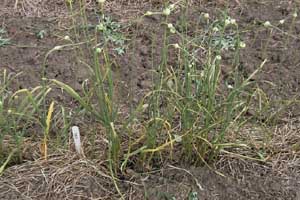

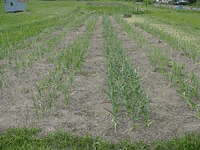
-underground bulb head
Within Bulb: CLOVES (8-12 typically)
Origins...History
Indigenious to: the Kirgiz desert region of Siberia (map showing location of Siberia)
Derived from Allium longicuspis (original species)
From Siberia, in Central Asia, it's not Exactly Clear Where Garlic Was First Cultivated (Yet Nomadic People May Play A Role)
Earliest Places Garlic Revealed: *8th Century B.C. grown in gardens of King of Babylon
*3000 B.C. Chinese Scholars mentioned garlic in their Sanskrit writings
Historical Ties to Different Groups of People:
-Confucius
- Egyptians Used Garlic as Currency and Referred to It in Rituals and Oaths
- Vikings and Phoenicians took garlic along on voyages
-Crusaders are credited with Bringing Garlic Back to Europe
What's in the name?
*The name Garlic comes from the Anglo Saxon garleac: Gar means a "spear" referring to the pointed leaves and Leac means "a plant"*
By 1000 A.D GARLIC IS WIDESPREAD!!!
Cultivated around the world: specifically~ Spain, France Egypt, Bulgaria, Hungary, USA, Mexico and Brazil
Over 600 Cultivated Species of Garlic originating from Allium Longicuspis
NOT ALL SPECIES ARE CONSIDERED TRUE GARLICS!!!!!
Get Ready for Some NAMES... Just to Give You
an Idea: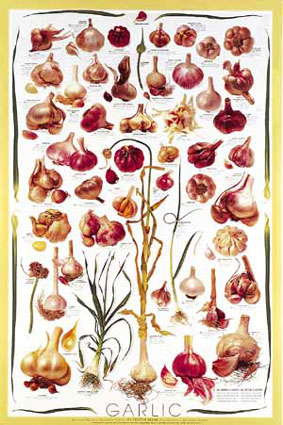
True Garlics are classified under the species Allium Sativum
Allium Sativum
2 Subspecies: A.) Ophioscorodon aka HARD-Necked Garlics
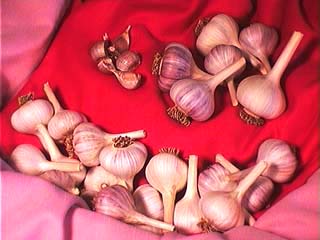 *Original Form
*Original Form
B.) Sativum aka Soft-Necked Garlics
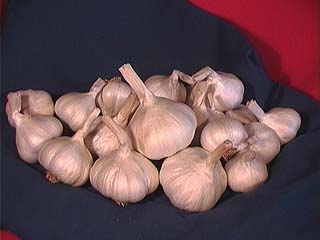 *developed
by growers from hard-necked
*developed
by growers from hard-necked
From the Hard-Necks there are 3Varieties :
I. Purple Stripe = 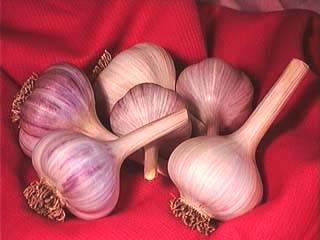 Purple
Stripe garlicsare usually vividly striped with purplish vertical stripes decorating
the bulb wrappers, hence their name.
Purple
Stripe garlicsare usually vividly striped with purplish vertical stripes decorating
the bulb wrappers, hence their name.
II. Porcelain = 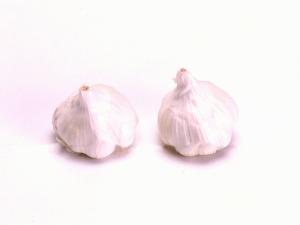 The
Most Beautiful, White with Thick Parchment Covering the Cloves.
The
Most Beautiful, White with Thick Parchment Covering the Cloves.
III. Rocambole =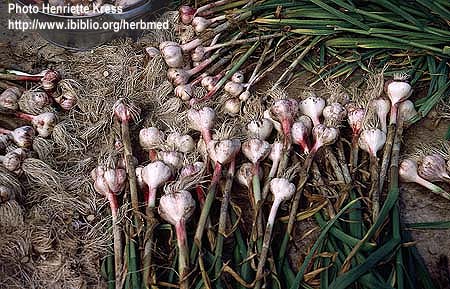
Rocambole garlics tend to have thinner bulb wrappers than other ophios and lots of purple striping and splotches. They are not as white as other ophios and seem to have a brownish cast to them, in fact, some of them almost look as though they need a bath
2 Varieties of Soft-Necked:
a.) Artichoke
Seen Most Often in US Supermarkets
b.) Silverskin
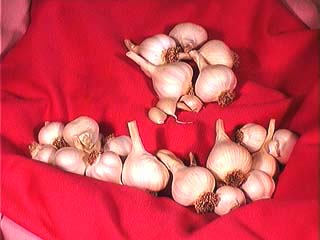
Silverskin garlics are usually, but not always, the ones that you see in braids. Silverskins are generally the longest storing of all garlics and have a soft pliable neck that lends itself to braiding and holds up over time better than the artichokes whose necks tend to deteriorate earlier than the silverskins.
Focusing on the USA...
California EARLY and California LATE varieties are grown and sold!
Distinctions: Early = White Skins, Rounder and Flatter Bulbs, Larger Cloves & planted in December for June harvesting
Late = Smaller Bulbs, Pink or Purplish Skin & harvested in July or August
*When in Doubt, Assume the Garlic You Bought was Late!!!
Back to the Stinking Rose Part:
 Why the
Smell?
Why the
Smell?
*Garlic Smells Due to a Chemical Reaction that Takes Place Whenever Cells are Broken*
This Chemical Reaction Ties into the Flavor of the Garlic, too!!!
*Different Tastes for Different Cooking Methods!!!
Getting to the ROSE PART...
Economics of Garlic:
*Large Demand = Need for a Large Supply for this "Spice of Life"
Industrially: -Through a proces of distillation with water, oil is isolated from cloves. This oil contains compounds essential in the creation of ALKENES (C=C).
Alkenes are used to manufacture: -extreme pressure lubricants
 -sealants
in the glass industry
-sealants
in the glass industry
![]() -binders
in solid propellants for rockets
-binders
in solid propellants for rockets
 -vulcanization
of Rubber to Increase Its Duriability
-vulcanization
of Rubber to Increase Its Duriability
Starting to Smell Better? OR Look More Pleasant?....Just Wait
Medicinal Properties
-Used As Long Ago at 5,000 years without Scientific Data...By the Visual Effects Were Enough Evidence!
-Current Knowledge Rests on the Sulfer-Containing Metabolic Compounds of Garlic
*Garlic contains a Great Deal of Sulfur: 67 mg/100mg of garlic
Where is it all? OIL = amino acid alliin and once cells within the clove are broken, the alliin is converted into allicin....an enzyme known as alline lyase catalyses the formation of allicin, which is the precursor for several other sulfur-containing compounds responsible for the flavor, odor, and pharmological properties of garlic.

Studies have attributed garlic to: ![]() Ajoene:Reduce Blot Clotting & Reduce Blood Pressure = Treatment of Cardiovascular
Diseases (Anticoagulants)
Ajoene:Reduce Blot Clotting & Reduce Blood Pressure = Treatment of Cardiovascular
Diseases (Anticoagulants)
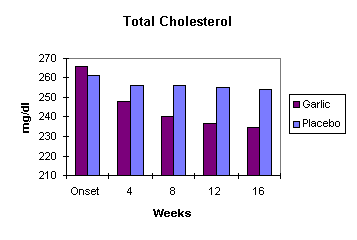
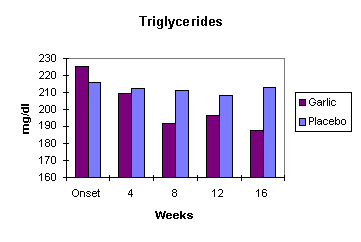
![]() Ajoene
also decreases bacterial growth
Ajoene
also decreases bacterial growth
 +
+  = :)
= :)![]() Lowered Incidence of Stomach Cancer
Lowered Incidence of Stomach Cancer
![]() Inhibits
Growth of Carcinoma Cells in Lung Cancer Patients
Inhibits
Growth of Carcinoma Cells in Lung Cancer Patients
![]() Improves the Overall Immune System
Improves the Overall Immune System
Basically It's Good for Whatever Ails You: Check Out the Specifics!!
Conclusion: Perhaps----
Each Day Rather...
![]()
So in Conclusion, Yes It's Stinky, But A Rose For Sooo many Reasons! (Health, Economy, Culinary, etc.)
Garlic: Truly a STINKY ROSE 
Now: 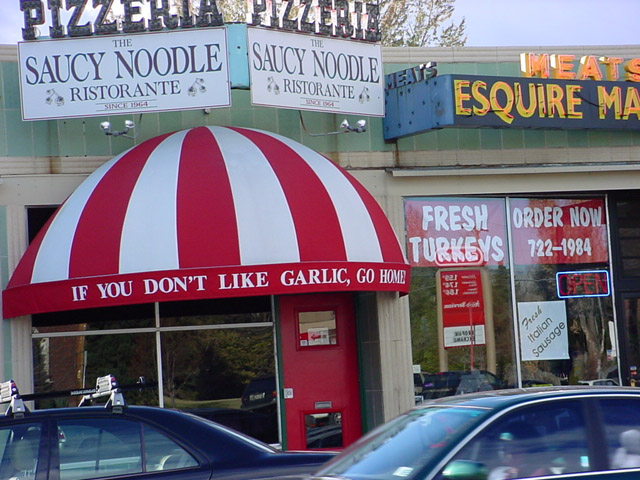
And Be Kind to the Earth! 
References
1. Watanabe, Tadashi D. Sc. 1974. Garlic Therapy. San Francisco, California: Japan
Publications Trading Company. pp 5-21.
2. Crawford, Stanley G. 1998. 1937- A Garlic Testament : Seasons on a Small NewMexico Farm. Albuquerque, New Mexico: University of New Mexico Press. pp 3-9.
3. Parthasarathy, V.A. 7 March 2002. Garlic. Indian Institute of Spice Research. http://www.iisr.org/spices/garlic.htm <Accessed 25 Feb. 2003>.
4. Howe, L. 1997. Garlic: A Miracle Right Under Our Noses. http://wellweb.com:80/ALTERN/column/garlic.htm <Accessed 26 Feb. 2003>.
5. Kloss, Jethro. 1994. Back to Eden. New York, NY: Collier Books. pp 43-44.
6. Iltis, Hugo. Feb. 1949.An Immigrant Conquers a Continent: The Story of the Wild Garlic. Scientific Monthly, Vol. 68, No. 2 pp. 122-128.
7. Mo, Yan. 1995. The garlic ballads; translated from the Chinese by Howard Goldblatt. New York, NY : Viking Publishing Co. p. 18-23.
8. Lichtwer, Pharma AG. 5 May 2000. A Brief History of Garlic. http://www.lichtwer.de/Seitenenglisch/e_gknob_2.htm <Accessed 25 Feb. 2003>9. Schou, Chad.
9. May 2000. Garlic: A Taste for Health. http://www.siu.edu/~ebl/leaflets/garlic2.htm <Accessed 26 Feb. 2003>
10. Anonymous. 1997. Health Benefits and Folklore. http://www.ibs.net:80/garlic/health.html <Accessed 27 Feb. 2003>
11. Gillespie, Angus Kress. 1999. Rooted in America : foodlore of popular fruits and vegetables. Knoxville, Tennessee: University of Tennessee Press. p. 135-137.
12. Sellers, Burt. 16 May 1999. Gourmet Garlic Gardens. http://www.gourmetgarlicgardens.com/overview.htm <Accessed 26 Feb. 2003>
13. All About Garlic. 2000. http://www.gourmetsleuth.com/garlic.htm <Accessed 25 Feb. 2003>.
14. Taylor,T, Clowes F. Nov 1978. Temperature and Coordination of Cell
Cycles within the Root Meristem of Allium Savitum. New Phytologist, Vol. 81, No. 3., pp. 671-680.15. Raghman, Abdur;Mann, Louis; Owenby, Marion; Berg, Rolf. May-Jun
1966. Taxonomy of American Alliums American Journal of Botany, Vol. 53, No. 5. pp. 477-484
16. Stern, David. 1993. The Garlic Farmers and Seed Foundation Lecture
Series. http://www.hopefarmbooks.com/garlicfest_lecture.html <Accessed 25 Feb 2003>17. Hilu, K.W. Dec. 1993. Polyploidy and North American Plants.
American Journal of Botany, Vol. 80, No. 12., pp. 1494 1499.
18. The Garlic Shoppe. 15 June 2000. www.garlicshoppe.com/shared/recipes/facts.html <Accessed 25 Feb. 2003>.
19. Foster, S. 1996. Garlic - Allium sativum. Botanical Series, No. 311. 2nd. ed. Austin, Texas: American Botanical Council.
20. Foster, Steven. 2000. Garlic. http://www.stevenfoster.com/education/monograph/garlic.html <Accessed 25 Feb. 2003>.
21. Gentry, A.H. 1992. A Synopsis of Bignoniaceae Ethnobotany and Economic Botany Annals of the Missouri Botanical Garden, Vol. 79, No. 1., pp. 53-64.
22. Mabey, R.; McIntyre, M.; Michael, P. Duff, G.; Stevens, J. 1988. The New Herbalist. New York, NY: MacMillian Publishing Co., Inc.